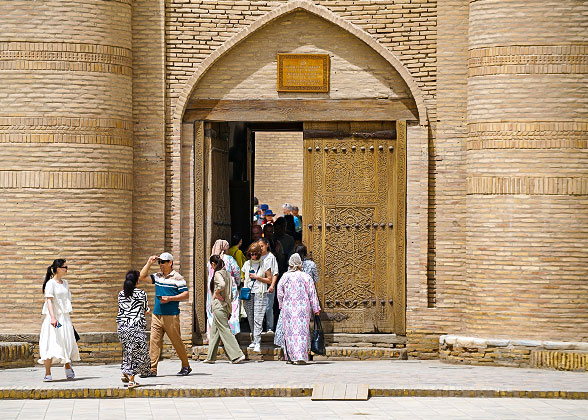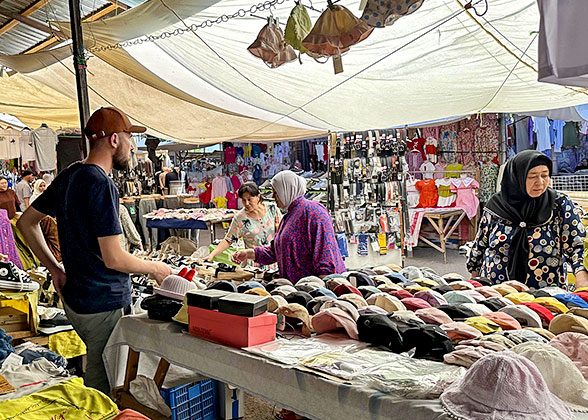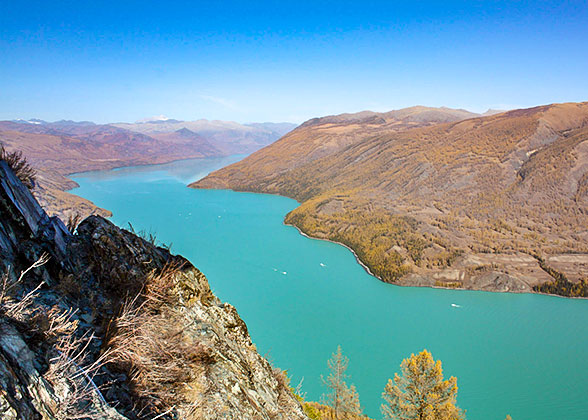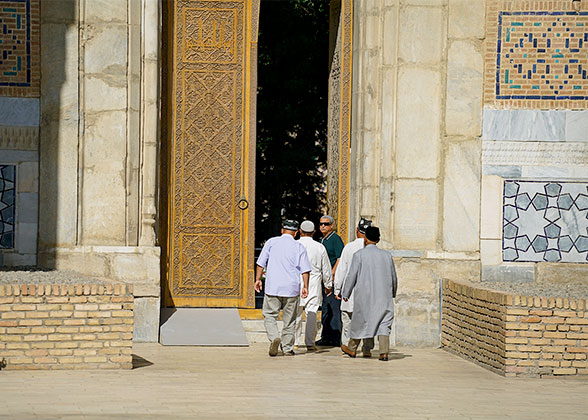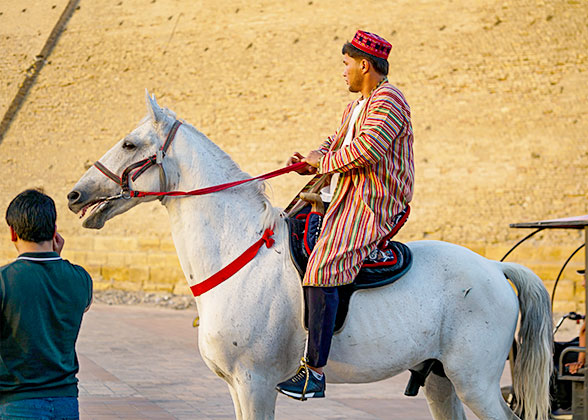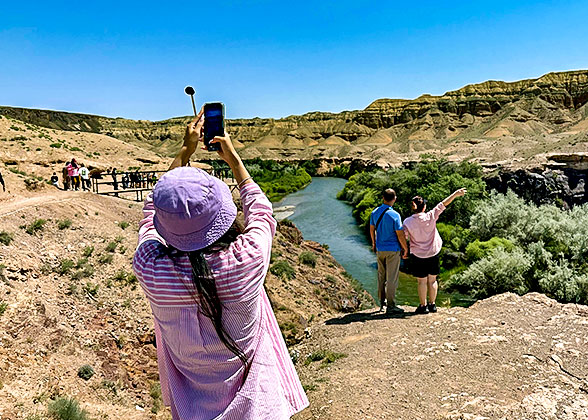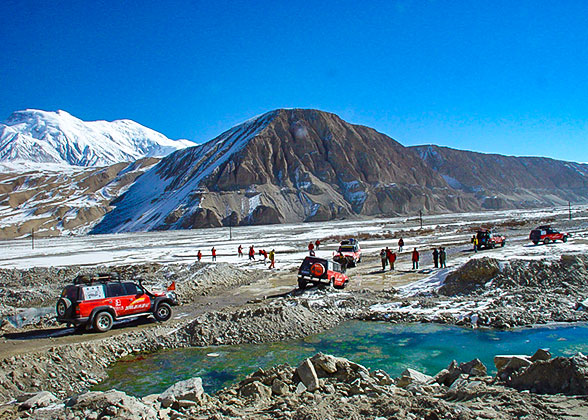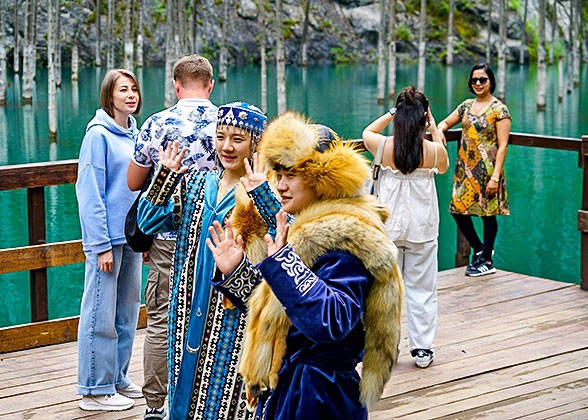Day 1: Dushanbe Airport Pick-up; Visit National Museum of Antiquities, Botanical Garden & Victory Park
Welcome to choose our north Tajikistan trips! When you arrive at Dushanbe, your private guide and the driver will escort you from the airport to the hotel. In the upcoming days, you’ll find that the capital city is a blend of diverse cultures and nature: Russian language signs throughout the city intermingle with traditional Persian Islamic mosques, and distant snow-capped mountains guard the modern facilities, all showing a distinct ambience of the city.
In the afternoon, kick off your tour in the National Museum of Antiquities. It was originally used for research and has been open to the public since 2001, with 22 exhibition halls displaying genuine exhibits, including jewelry, coins, ceramic products, ancient weapons, and musical instruments. The 13-meter (43-foot) long clay reclining Buddha image, the biggest of its kind in Central Asia, and murals unearthed in Panjakent, depicting hunting and court banquet scenes, are the highlights! Then, stroll around the Botanical Garden, the city's tranquil oasis teeming with colorful flowers, towering trees, the melodious chirping of birds and fresh air. During Nowruz Day, the Tajik New Year festival, which falls around March 21st, you may encounter local people in traditional ethnic clothing dancing to celebrate. Afterward, visit Victory Park, a solemn site in honor of the victory and deceased soldiers of the Eastern Front War (1941-1945). After the visit, you’ll be transferred to the hotel.
► Dinner Recommendation (at your own expense)
Plov (stir-fried rice), samosas (grilled buns), and grilled meat are classic Tajik delicacies and can be easily found in restaurants and street food stalls. The samosas are made of seasoned meat and chopped vegetables wrapped in dough and baked in a tandoor (clay oven), featuring a golden and crispy crust and flavorful filling, and are usually served with refreshing kurtob yogurt. Such a feast for the taste buds! You can try some at the specialty Toqi Teahouse, which boasts a comfortable and exquisite environment, offering indoor and outdoor tables and private rooms at reasonable prices. It’s advisable to make a reservation in advance.
Average Cost per Person: TJS 150-200 (USD 15-20)
Address: Ul. Kurbona Raximova, 29, Dushanbe
► Insider Tips
1. GBAO Permit: A GBAO permit is a must for all visitors visiting the Pamirs, and you can obtain it by selecting the corresponding option when applying for an e-visa.
2. Climate & Temperature: North Tajikistan is generally rainy and snowy in winter and spring (Dec.-May), while dry and hot in summer and autumn (Jun.-Nov.), with the highest temperature soaring to 40°C (104℉) and the lowest dropping to -20°C (-4℉). Pack appropriate clothing according to the time you visit. Besides, alpine lakes like Iskanderkul and Alauddin are cold and windy even in summer, so thick clothes, sunglasses, and a hat with a rope are highly recommended.
3. Religion: Although Tajikistan has Islam as its main religion, it is far more secularized and open-minded than traditional Muslim countries. There is a strange law that the Tajik women are not allowed to wear a hijab, the Muslim headscarf!
Accommodation: Hotel Atlas Dushanbe (4 stars) or similar
|
Day 2: Dushanbe: Hisor Fortress, Rudaki Park, National Museum, Navruz Palace & Local Bazaar
After breakfast, we’ll drive for an hour to Hisor Fortress, an open-air museum with a history of nearly 3,000 years. It has undergone multiple devastations, reconstructions and expansions during different political regimes, and one of the newer buildings is the overnight lodges for ancient Silk Road merchants and camels. It’s advisable to wear comfortable walking shoes, as you’ll walk on cobblestone roads. Then, wander around Rudaki Park, a hotspot with fountains, parterres, and the statue of the famous Persian poet Rudaki, which is always brimming with locals taking leisurely walks and teenagers practicing skateboarding. Dushanbe boasts many Soviet-style buildings and we’ll then take in the essence of the architecture from the exterior, including the National Library, the Palace of Nations, the Stele with the Emblem of Tajikistan, the Ministry of Internal Affairs, and the Parliament. We’ll also admire the Statue of Ismoil Somoni, the founder of the first Tajik state in the 10th century. After the country declared independence, Somoni’s statues replaced the Lenin statues all over the city. Afterward, view the Dushanbe Flagpole, which was built to commemorate the 20th anniversary of the country's independence. As the world’s second-tallest flagpole, it is 165 meters (541 feet) in height and weighs 700 kilograms! Next, head to the National Museum and browse the historical relics, animal and plant specimens, paintings, national costumes, gifts from other countries, etc. Although there are replicas here, such as a copy of the reclining Buddha at the National Museum of Antiquities, it is still an excellent place to gain a comprehensive understanding of Tajikistan's history and culture. Then, marvel at the magnificent Navruz Palace, taking nearly 6 years to build for international conferences and summits, whose grandeur is preserved in exquisite handicraft decorations, including Florentine mosaic, cedar wood carvings, massive crystal chandeliers, and parquetry floors. Inlaid with pieces of glass and mirrors, the opulent Mirror Room is most eye-catching. Leaving the spectacular palace, we’ll go for a local bazaar exploration. Bazaar is a symbol of Central Asia, and Dushanbe, meaning "Monday" in Persian, got its name from the market regularly held on Mondays in the past. We’ll round off today with a visit to the Asian Bazaar, packed with a wide variety of goods, including fruits, colorful spices, plump dried fruits and traditional clothing, as well as local snacks like samosas, plov and kebabs. It’s a great place to prepare some provisions for the upcoming long drives and enjoy a special local dinner on your own. Meal: Breakfast Accommodation: Hotel Atlas Dushanbe (4 stars) or similar Hisor Fortress, Dushanbe Visit Asian Bazaar
|
Day 3: Dushanbe to Kalai-Khumb by 8 Hours' Drive
Today, embark on an 8-hour road trip to the mysterious Pamirs, hailed as the "Roof of the World", featuring harsh desert plateaus and snow-capped peaks over 7,000 meters (22,966 feet) above sea level! We’ll drive towards the secluded and slow-paced border town of Kalai-Khumb, the first stopover along the Pamir Highway from Dushanbe. Drive southeastwards until we arrive at Nuruk town, and stop to appreciate the Nurek Reservoir on a viewing platform from afar. The vast blue waters set against the backdrop of red mountains and magnificent canyon scenery make it a summer resort for locals to enjoy aquatic recreation. Behind the reservoir is its namesake dam, the world's second-highest of its kind. After that, continue our trip and pass by the 2,267-meter (7,437-foot) high Shuraba Pass, and drive along the Panj River, the border river between Tajikistan and Afghanistan. Most sections of the river are only a few dozen meters wide, with Afghan villages scattered just opposite the bank. Upon arrival in Kalai-khumb, check into the hotel, turn on the TV and seize your chance to watch Afghan TV programs!
► Tips
1. Today, we’ll gradually drive from low-altitude to higher areas. It’s recommended that you wear thick clothing, and bring anti-altitude sickness medication and an oxygen tank.
2. As there are long drives during those days, you can pack a neck pillow and cotton slippers to make your journey more comfortable. Additionally, bring some favorite snacks, as there are limited food options at restaurants along the Pamir Highway.
Meal: Breakfast
Accommodation: Karon Palace Hotel Kalai-Khumb (4 stars) or similar
|
Day 4: 7-Hour Road Trip from Kalai-Khumb back to Dushanbe
Today, we’ll return to Dushanbe. Located on the north bank of the Panj River’s northernmost section, Kalai-Khumb sits at an altitude of around 1,200 meters (3,937 feet), and we’ll gradually ascend higher and pass through the 3,252-meter (10,669-foot) high Khaburabot Pass. Along the way, the bumpy roads are accompanied by stunning views of snowy summits and a vast azure sky dotted with thick clouds. You may encounter traditional and unpretentious Pamiris, aka the Mountain Tajiks, who wear thick cotton or leather clothes, herding their herds of sheep or cattle. They are accustomed to the harsh environment of the barren plateau and make a living through farming and herding. You may also find that Pamiri females like wearing red, which makes them look full of vitality on the snowy plateau. After arriving in Dushanbe, check in at the downtown hotel.
► Recommended Activities in Dushanbe (at your own expense)
If you’re running out of supplies, you can go to the well-stocked Arzanda supermarket on Rudaki Street to prepare some for the coming journey. It is also possible to savor the culinary delights of Turkish cuisine when passing the nearby Citir Usta Restaurant, whose signature dishes include kebab platters, cheese pies, and baklava, a pastry of phyllo dough and nuts. Besides, don’t miss a cup of Turkish tea. The average cost per person is around TJS 50-100 (USD 5-10). Credit cards are accepted in both the supermarket and the restaurant.
Meal: Breakfast
Accommodation: Hotel Atlas Dushanbe (4 stars) or similar
|
Day 5: Drive 3 Hours to Iskanderkul Lake; Hike to Admire Iskanderkul Waterfall and Snake Lake
★ Hike around Iskanderkul Lake, a Gem of the Fann Mountains!Today, we’ll drive 3 hours to the Iskanderkul Lake, an alpine lake nestled in the magnificent Fann Mountains, drawing people with its turquoise water, which transforms colors with the changing light. Legend has it that when Alexander the Great invaded the region, he encountered stiff resistance. The furious conqueror ordered to dig the riverbed to drown the hostile army, thus forming Iskanderkul Lake. Before reaching the lake, we’ll catch a bird's-eye view of the surrounding scenery at the 3,372-meter (11,062-foot) high Anzob Pass, one of the most dangerous passes in Central Asia, as the area is prone to avalanches and falling rocks and frequently shrouded in mist. Don't worry, your skilled driver will ensure a safe journey. Upon arriving at the lake, your private guide will accompany you to enjoy a 40-minute hike to admire the Iskanderkul Waterfall, during which the serene lake, the vast land of lush greenery, and breathtaking rugged mountain views will leave you spellbound. You may see a rainbow near the waterfall and people swimming in the lake on a sunny day. Continue west to the waterfall, and take in Snake Lake, which is named for the water plants that look like snakes. The rest of the day is at your disposal to go on the hike with your guide, rent a boat to tour the lake on your own, or just soak up the tranquil atmosphere by the shore. Tonight, stay overnight in a hotel by the lake.
► Tip: Please note that the hiking route includes potholed gravel roads and uphill sections, so wear hiking shoes. Besides, a hat and sunscreen are also recommended to protect from the wind and ultraviolet rays.
Meal: Breakfast
Accommodation: Zumrad Guesthouse, Iskanderkul Lake or similar
|
Day 6: Drive through Alauddin Lakes to Panjakent; Visit Sarazm, Rudaki Museum & Ancient Panjakent
The next stop of your north Tajikistan itinerary is Panjakent, nestled in the Zarafshan River Basin, a pivotal hub along the ancient Silk Road in the Sughd region. From the 5th to 8th centuries, the business-savvy Sogdians actively engaged in trade along the Silk Road, reaching China in the east, India in the south, Persia and Byzantium in the west, and Mongolia in the northeast. Drive northwestwards, passing through the Zarafshan Valley and Alauddin Lakes in the Fann Mountains, and immerse yourself in the stunning views of rugged and winding mountain roads, lush vegetation, crystal-clear lakes, and snow-clad peaks, all of which contribute to the reasons why the Fann Mountains lure a large number of hikers. Arrive in Panjakent in 5 hours, and your private guide will accompany you to explore the ancient city of Sarazm, one of the oldest cities in Central Asia, dating back to 4000 BC to 3000 BC, and the first UNESCO World Heritage Site in Tajikistan. Take a glimpse of the ancient settlement’s remnants, including the mud-brick houses, well-planned streets, and even metallurgical workshops. Imagine how advanced such technology was back then! One of the city’s most treasured discoveries is the "Lady of Sarazm" (now preserved in the museum), a woman’s well-preserved skeleton along with a large number of beads and jewelry, including shells from distant oceans. Then, visit the Republican Museum of History and Local Lore of Rudaki, which displays exhibits including the tools and pottery jars unearthed from Sarazm, elaborate national embroidery costumes, as well as 19th-century coins and books. You’ll also be smitten by the ancient murals, which are among the most crucial cultural relics of Panjakent, incomplete but still rich, depicting festival ceremonies, battles and hunting scenes, heroic epics, folk tales, etc. Some of them, portraying the Sogdian nobles wearing luxurious Chinese silk, testify to the prosperity of the ancient Silk Road. The Ancient Town of Panjakent built in the 5th century, is our next stop. On the present ruins, we can still see the city’s considerable scale and vaguely recognize the outlines of the main roads, two-story and three-story mansions, neatly arranged shops, inns and other buildings. Round off today’s sightseeing with a local bazaar. Although it isn’t on a large scale, it presents the most authentic daily market scenes, bustling but not chaotic: stalls serving piles of different pickles, colorful spices, dried fruits, fragrant baked naans and steamed buns, as well as locals carefully selecting the goods while bargaining with vendors. At last, you’ll be escorted to the hotel. Meal: Breakfast Accommodation: Panjakent Plaza Hotel (3 stars) or similar
|
Day 7: Seven Lakes Discovery with Scenic Hikes, Back to Panjakent
After breakfast, we make our way to the Seven Lakes, a chain of glacial lakes in the Fann Mountains, which are at altitudes ranging from around 1,600 meters (5,249 feet) to 2,400 meters (7,874 feet), with varied sizes and hues of indigo, turquoise, and blue. Folklore has it that a blacksmith and his seven daughters lived in the valley, and the old governor wanted to marry the youngest girl, who was reluctant and asked him to build a magnificent palace within 40 days. Surprisingly, he made it, but on the wedding day, the girl jumped off the palace, forming a lake, and her sisters' tears turned into the other six lakes.
After a 1.5-hour drive, we’ll arrive at the 4th lake, Nofin, and kick off a 1.5-hour hike, along which you may encounter simple shepherds, women wearing ethnic embroidered long robes and patterned headscarves, and little girls trying to sell souvenirs. Why not ask them for permission to take some memorable snaps? Afterward, continue driving to the 6th lake, Marguzor, the largest among the seven, where primitive rock paintings were discovered. Hop out of the car and hike over a hill to reach the 7th lake, Hazorchasma. On the hilltop, take in panoramic views of the lake flowing down into Marguzor at the bottom of the valley, layers of mountain slopes with dirt winding paths, and cottages hidden among the lush vegetation. At last, you’ll be transferred back to the hotel in Panjakent.
► Tips:
1. The gravel roads after entering the mountains are rugged and desertified, with dust flying everywhere, so a dust mask is highly recommended.
2. The temperature would drop, along with changeable weather, as we ascend. Thus, a thick coat and rain gear are necessities.
Meal: Breakfast
Accommodation: Panjakent Plaza Hotel (3 stars) or similar
|
Day 8: Drive from Panjakent to Khujand, with a Stop at Istaravshan
Our final destination today is Khujand, the second-largest city in Tajikistan and one of the oldest cities in Central Asia, which dates back to 329 BC. We’ll traverse the 5-km (3-mi) long Shahriston Tunnel to conquer the 3,378-meter (11,082-foot) high Shahriston Pass. It’s said that before the tunnel was put into use, it would have taken more than 10 hours to travel by the winding mountain roads from Dushanbe to Khujand! Moreover, landslides and avalanches occurred easily, making the only path connecting the north and the south frequently blocked in the old days.
After a 4-hour drive, we’ll arrive at Istaravshan, an ancient trade center in Central Asia, and admire some highlights of the city. The first stop is the hilltop Fortress Mug Teppe, a prominent historical site stormed by several renowned rulers, including Alexander the Great, and was eventually left with only ruins and debris. Walk through the impressive gate topped with a huge golden dome, which was built to celebrate the city’s 2,500th anniversary in 2002, and enjoy a panoramic view of the entire city on the brick city wall. The Kuk Gumbaz Mosque, nestled in the narrow labyrinthine streets, is our next stop. Be smitten by its eye-catching blue dome, which earned the mosque its name, Kuk Gumbaz, locally meaning “blue dome". Istaravshan is also renowned for its folk handicrafts. It has preserved over 100 kinds of ethnic crafts, among which the most famous are handmade knives, and we’ll stroll through the famous handicraft workshops and meet the master craftsmen.
Say farewell to Istaravshan and continue driving to Khujand. After checking in, you can either rest or explore the city on your own. Over 90% of Tajikistan is mountainous, while Khujand, dubbed "the gateway of the Fergana Basin", sits on a plain with the clear Syr Darya River flowing through the city. The excellent location made it one of the hometowns of Sogdian merchants.
► Recommended Activity in Khujand (at your own expense)
If you are still energetic, try the Khujand cable car, which slides over the Syr Darya River, to appreciate the stunning night views. You can take it at either of the two entrances: one in Somoni Park, and the other inside Park Kamal Khudzhandi. It operates from 18:00 to 3:00, and a one-way trip is around 20-25 minutes. A long bench seat costs TJS 15 (USD 1.5), while a sofa seat costs TJS 20 (USD 2).
Meal: Breakfast
Accommodation: Parliament Hotel Khujand (4 stars) or similar
|
Day 9: Khujand: Historical Local Lore Museum, Panjshanbe Market & Arbob Cultural Palace
Today, we'll mainly dive into Khujand, and your private guide will first accompany you to visit the Historical Local Lore Museum of Archeology and Fortification, a distinctive structure featuring a Central Asian fortress built on the ancient city wall. In the three sections on the first floor, learn about the histories of ancient times, the modern Soviet period and the independence of Tajikistan through rich artifacts, including stone carvings, musical instruments, and traditional costumes. Afterward, descend to the underground and marvel at the astonishing mosaic murals, composed of over 1,000 marble pieces, showing the legendary life and impressive battle scenes of Alexander the Great, who is said to be the founder of Khujand. Then, head to the city center square and admire the Mausoleum of Sheik Muslekheddin, which is in memory of the city’s 12th-century ruler who was also a respected poet. On the other side of the square, experience the vibrant Panjshanbe Market, one of the oldest markets in Tajikistan. Does the name remind you of Dushanbe, which means “Monday”? Panjshanbe refers to “Thursday”, from which you must have guessed that this market is held on Thursdays. Outside the building, a bustling array of stalls is scattered around. The huge indoor market combines Soviet and local styles, adorned with a hemispherical domed portal decorated with bright paintings and sculptures. On the first floor, browse countless stalls orderly teeming with naan, fresh fruits, dried fruits, vegetables, honey, dairy products, etc. Ascend to the second floor, and you can find clothing, school supplies, and daily necessities, as well as an excellent viewpoint to capture the lively scenes of the first floor. In the afternoon, visit the Arbob Cultural Palace, which was modeled after the winter garden of Peterhof Palace in St. Petersburg and was once the former headquarters of the Soviet collective farm. Be smitten by the exquisite columns, arches, colorful mosaics, fountains, and Russian-style gardens, which beckon new couples to take wedding photos here. Round off today with a visit to the Qairoqum Reservoir, a huge artificial lake reckoned as the "Tajik Sea" by the locals. The turquoise water, along with sandy beaches, is a summer paradise for the inland residents. Meal: Breakfast Accommodation: Parliament Hotel Khujand (4 stars) or similar
|
Day 10: Drive 7 Hours from Khujand to Dushanbe
As the sightseeing in Khujand finishes today, we’ll drive back to Dushanbe. The 300 km (186 mi) journey starts with a flat asphalt section, gradually followed by winding mountain roads, bumpy and gravelly, with breathtaking views from towering snow-capped mountains and vast open plains to scattered villages dotted in the greenery and abandoned mine pits. What’s more, you might encounter brave cyclists, who are beckoned by the perilous but incredible natural beauty! We’ll also pass through the 5-km (3-mi) long Anzob Tunnel, which was once called the "Tunnel of Death" due to the lack of lighting and ventilation facilities, as well as numerous pits. Finally, arrive in Dushanbe and check in at the hotel, and the rest of the day is on your own.
► Recommended Activity in Dushanbe (at your own expense)
To recover from the long drive fatigue, you can stretch your legs at Sadbarg, a popular trade center in the city center, with shopping malls abounding in jewelry, electronics, and clothing, as well as street stalls teeming with fresh fruits, vegetables and daily necessities. Maybe you’ve noticed people standing by the roadside eating a kind of fluffy bread - that’s a potato pie. Why not have a try?
Meal: Breakfast
Accommodation: Hotel Atlas Dushanbe (4 stars) or similar
|
Day 11: Dushanbe Departure, Airport See-off
Today, bid farewell to your north Tajikistan tour. Your private guide and the driver will transfer you to the airport at the agreed time and see you off. Wish you a pleasant journey home!
Are you interested in other regions of the country, such as the fabled Wakhan Corridor? Or are you curious about the other four Central Asian countries - Kyrgyzstan, Uzbekistan, Kazakhstan and Turkmenistan? We can offer you a hassle-free trip of the Pamirs covering the Wakhan Corridor and exclusive routes for the mentioned countries, as well as itineraries of different combinations in one go, all of which can be customized according to your preference. Welcome to consult our travel advisors!
Meal: Breakfast
|

